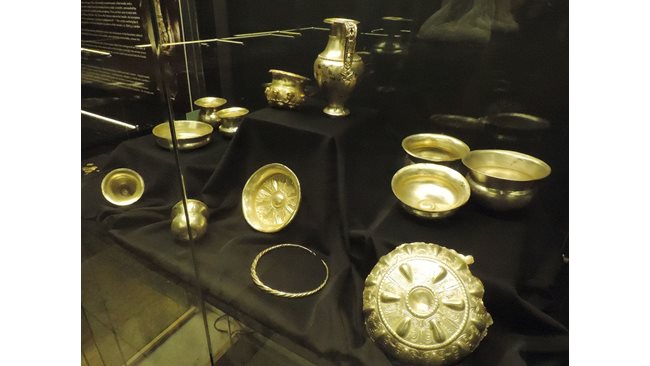He received BGN 15,000 from the state, the denomination melted them to BGN 1,500
From the distant 1953 until now a lot of water has flowed, the memory of the discovery of the Lukovit treasure has faded – she left with the participants in it. It is a strange fact that over time the names of the discoverers are forgotten. That is why only a few in Lukovit know that Tsanko Mishev Gerchev excavated some of the richest Thracian artifacts in our lands.
Readers asked us to recall this interesting story, which we published in 2008. We met then with Nikolai, Tsanko’s son – only he could tell exactly how his father came across the exclusive silver objects. And he did it in a very fascinating way. We looked for him again now, but unfortunately his husband had left this world. However, the journalistic notebook has preserved the curious story of the treasure.
“In the spring of 1953, my father was 46 and I was 4. I was born late and I am the only child of my parents,” Nikolai’s story once began. His father was a master builder, he was sought after by the city and its surroundings to build houses, and there was still no time for field work. That is why he asked a neighbor to plow his fields in the Balan area outside Lukovit. The man went and diligently closed the ground, but at some point it rained and he could not finish – he was left with a small piece of nine acres.
A few days later, the owner of the property harnessed his cow, took a neighbor’s cattle, and went to dawn. “Dad used to say that on the first or second furrow the plow stuck. He thought it was a rhizome, but when he bent down to clean it he saw pieces of a clay jar and various metal vessels between the lumps,” Nikolai continues.
Until there was Tsanko with the plow. And that he found no treasure at all and did not think, because it was not in the conventional form. True, it was poured from a jar, but it was not coins or jewelry with precious stones, but vessels of some kind. He dug his finger out of it, dug out what he could from them, loaded them into the cart, and headed for the city.
“Hey, people, come see what scoops I found,” he called out to the neighbors as he returned. They came curious, but no one was impressed by the darkened cups, vases and the like. Tsanko generously invited them to take whatever they liked. And people chose something before they left.
In the following days, life went on as before – everyone started their own work. However, some of the neighbors, having washed the “ladles” out of the mud, shone the precious metal below, after which the rumor quickly spread around the city. It was rumored that Tsanko the master had found a treasure that reached the authorities. “Then they came from the Council with the police, asked Dad where, how and what he had found. Then they said that everything had to be confiscated,” Nikolai recalled. His father reluctantly handed over the items in his house. Only that his mother Rada set aside a vase without them seeing it – she wanted something to remember. Flowers and various braids were engraved on the vessel, the heir describes. Municipal officials also toured neighboring houses to collect the rest of the treasure.
Then archaeologists and historians arrived, excavated the site and removed more objects – a total of about 200. In addition to the 13 silver vessels – phials, vases and a bowl, three iron bridles and bronze teeth were found, various silver rings, buttons from horse necklace, three sets of decorations of horse harnesses, as separate parts of them are gilded, and one consists of a chief and four applications, cast in silver. A gold plate is applied on their front side.
According to historians, the Lukovit treasure largely reflects the peculiarities of Thracian art and the stages of its development in the 4th century and the beginning of the 3rd century BC. It was owned by a local dynasty or a prominent member of the tribal aristocracy. Probably alarming events forced the noble Thracian to put the treasure in a large clay urn and bury it in the ground, where it has remained hidden for more than 20 centuries, experts suggest.
For years, treasure hunters searched the levels of Master Tsanko in search of another treasure. Their enthusiasm was fueled by the archaeological conclusion that the treasures were not buried in their entirety – they were divided into two halves, which were hidden in different places. To date, however, the other part (if any) has not been found.
The clay jar was broken into small pieces, which were scattered in the mud, Nikolai explained. After a while, the “culprit” for the appearance of the Thracian objects received by mail 15 thousand levs – the state bought its ownership of them. “My father often said that with this money he could buy a house,” Nikolai continues. However, he had already built a house, made good money from his craft, so he contributed the thousands to DSK. The son did not need them either, as he worked as a refrigeration technician. The levs matured there until the denomination devalued them to 1,500.
Until his death in 1982, Tsanko Gerchev made a living for his family. He was always chopping, hammering and doing something – his hands did not know peace. His faithful companion, Grandmother Rada, followed him to the afterlife soon after. Memories remain, the vase and an application that survived tucked away among the vehicles. And Nikolai and his wife, engrossed in raising their two daughters, completely forgot about Grandpa Tsanko’s find and the memory of Grandma Rada.
One day in 1985, a numismatist from Etropole arrived in Lukovit. It is unknown how and where he learned that Nicholas owned a Thracian vase. These were requests and exhortations, roads and paths he made to persuade him to give him the valuable thing. “I refused for a long time, explaining to him that it was a legacy and a memory from my parents,” the technician said. The stubborn collector did not smell, although at that time he did not know that a phial complements the collection of memories of the Gerchevi family.
Nikolai acquired it in a strange and somewhat comical way. Grandpa David lived in a house opposite theirs. Once he visited him, he was surprised to see that the old man was mixing shaving foam into a silver bowl. When Tsanko was handing out the treasure with wide fingers, the neighbor took a phial and used it all the time when shaving. “Oh, Grandpa David, do you know how old that is,” Nikolai said, and asked the old man to give it to him. Although he regretted parting with his useful vessel, his grandfather returned it to his heir.
The Etropole’s visits became so frequent that it no longer lasted. And when he realized that Nikolai would not be so inclined to give up the vase and the phial, he offered Trump – five golden Napoleons against them. After much thought, Nikolai agreed to make the exchange.
However, he had a premonition when he gave the silverware, so he explicitly warned the numismatist not to trade them abroad. “I told him they would be known immediately as part of the treasure – not to risk it,” Nikolai recalled. However, the collector did just that and was caught trying to export the valuable antiques.
After 10 days, Nikolai was summoned for questioning at the Central Investigation Department. “I will never forget room 504 and the threats from investigator Botev,” who said that if he had more power, he would perform a miracle. And Nikolai replied that this was an inheritance from his father – he was convinced that he could dispose of it as he wished.
The trouble did not end with the Investigative. Nikolai was later called as a witness in a case against the Etropole. He explained again in court how he thought he had the right to sell the artifacts bequeathed to him by his parents. The magistrates dispelled his delusion, the Napoleons were, of course, taken to the militia, and only a report was served on them.
After all the negative experiences around this story, Nikolai decided to hand over the silver applique with a gilded horseman and a lion at his feet, which he was still hiding at home. He took the tile to the Historical Museum in Sofia in 1987. At our meeting he claimed that the tiles found by his father were four. However, two were kept in the vault of the museum, and the one he donated became three. Only he couldn’t see them both during his visit. “They looked for them, but they didn’t find them and sent me away,” the man said. He was sure that the third application was not recorded anywhere, as he had not received any document. His suspicions of dishonesty on the part of museum workers at the time were strong. So he thought it fair to get the Napoleons back.
After 1989, he managed to regain only the levels – the same one where the treasure was buried. The remaining 60 decares of his father’s lands and forests proved difficult to prove for the simple reason that Nikolai inadvertently destroyed the property deeds.
“I cultivated the fields for a short time – it takes time, equipment, a lot of work and money. I gave up these agricultural aspirations and leased it,” said the refrigeration technician. Wondering what his family had gained from the priceless Thracian treasure, he immediately replied – nothing. In material terms, it did not affect his existence in any way. In emotional – brought only trouble.
“We do our best to have a copy or replica of the treasure. We have built a special hall where it will be presented in all its glory. I hope in this way to make the people of Lukovit proud of the ancient and rich land on which they live. And the name of Tsanko Gerchev will stand in a prominent place along with the wealth he discovered – it will not be forgotten, time will not erase it, “said the mayor of Lukovit Ivan Grancharov.
– .


